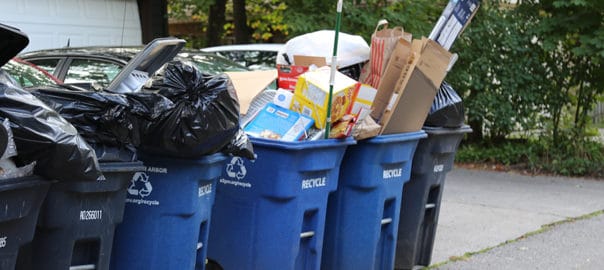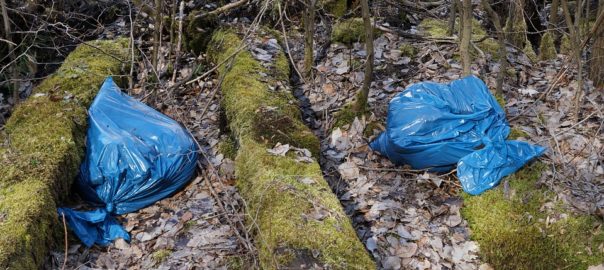Garbage Bag Terminology
Below is a list of common garbage bag terminology.
Additives
A diverse group of speciality chemicals incorporated into plastic formulations before or during processing, or to the surfaces of finished products after processing. Their primary purpose is to modify the behaviour of plastics during processing or to impart useful properties to fabricated plastic articles. (Modern Plastics Encyclopedia 1995).
Biodegradable
Biodegradable is defined as “Capable of undergoing decomposition into carbon dioxide, methane, water, inorganic compounds, or biomass in which the predominant mechanism is the enzymatic action of microorganisms, that can be measured by standardized tests, in a specified period of time, reflecting available disposal condition.” For practical purposes claims about biodegradability of plastic should specify a time frame.
Blown Films
Plastic films produced from synthetic resins (such as polyethylene) by the blown process. In this process, the molten resin is extruded through a circular die into a tube. This tube is expanded (“blown”) by internal air pressure into a larger bubble with a much reduced wall thickness and cooled with external air quenching.
Bottom Seal
Term used to describe the bottom seal of a garbage bags.
The three types of bottom seals are:
FLAT SEAL – Straight seal along bottom of a can liner (looks like a pillow case). The flat seal is used to create the strongest possible seal for heavy weight bags.
STAR SEAL – The star seal is the most common type of seal in the market. Designed without gussets, the star seal eliminates gaps along the seal where leaks can occur. This allows the bag to easily conform to the shape of the container and distribute the weight of the contents evenly inside the bag. This type of seal maximizes the bag’s carrying capacity while minimizing the likelihood of leakage.
GUSSET SEAL – A flat-style bag manufactured with both sides tucked in to form gussets. Also refers to the distance across the open face of the folded side or pleat: can also refer to the tuck or pleat itself.
Cast Film
Plastic film produced from synthetic resins (such as polyethylene) by the cast process. In this process, the molten resin is extruded through a slot die onto an internally cooled chill roll.
Co-Extrusion
The simultaneous extrusion of two or more different thermoplastic resins into a sandwich-like film with clearly distinguishable individual layers.
Compostable
Compostable materials are capable of undergoing biological decomposition in a compost site, to the extent that they are not visually distinguishable and break down to carbon dioxide, water, inorganic compounds, and biomass, at a rate consistent with known compostable materials.
Conversion
The term used to indicate converting plastic bags from a continuous roll to separate bags in a given configuration.
Cored Rolls
Bags or tubing is rolled on cardboard cylinders (looks similar to a roll of paper towels).
Coreless Rolls
Bags are rolled with perforations or are interleaved in a roll configuration.
Degradable
Degradable materials break down, by bacterial (biodegradable), thermal (oxidative) or ultraviolet (photodegradable) action. When degradation is caused by biological activity, especially by the enzymatic action of microorganisms, it is called ‘bio-degradation’.
Elasticity
The tendency of a body to return to its original shape after it has been stretched or compressed.
Film Strength
This term refers to the physical strength of the garbage bag. Some resins have higher film strength than others. Our bin liners are made from highest quality resins, giving them the highest quality film in the market place.
Various types of strength testing are:
Dart Drop Test – ASTM test used to determine the resistance of a bag to local failure or puncturing.
Elmendorf Tear Test – ASTM test used to measure the resistance to tearing.
Wet Load Capacity – Measurement of how much wet weight a can liner will hold.
Dry Load Capacity – Measurement of how much dry weight a can liner will hold.
Gauge
Term used to describe thickness of a plastic sheet, measured in mil’s or microns. Mil (One thousandths of an inch)
Gusset
Gussets are indented folds on the sides or bottom of a garbage bag that allow the bag to expand up to the limits of the fold in order to comfortably accommodate variable volume or shaped contents. Gusseted bags have three dimension measurements; Side Seal = W X Gusset X Length; Bottom Gusset = W X L + BG.
HDPE (High Density Polyethylene)
This is the acronym for High density, (0.95-0.965) polyethylene. It has much higher stiffness, higher temperature resistance and much better water vapour barrier properties than LDPE, but it is considerably hazier.
LDPE (Low Density Polyethylene)
This resin was used with older garbage bag technology. The resin has good clarity but weak film strength. Today it is used primarily for Food and Utility bags. Plastic used predominantly in film applications due to its toughness, flexibility, and relative transparency. LDPE has a low melting point, making it popular for use in applications where heat sealing is necessary. Typically, LDPE is used to manufacture flexible films such as those used for plastic retail bags and garment dry cleaning, and grocery bags. LDPE is also used to manufacture some flexible lids and bottles, and it is widely used in wire and cable applications for its stable electrical properties and processing characteristics.
Plastic Film
Is a very thin piece of thermoplastic resin that is considerably longer than it is wide with a thicknesses of 10 mils (1 mil = 0.001 inch) or less (averaging 0.7 mils to 1.5 mils).
Polyethylene
A lightweight thermoplastic used especially in packaging. Polyethylene (PE) molecules have two hydrogen atoms attached to each carbon atom in a chain. This structure gives polyethylene it’s tough, flexible and chemical resistant characteristics.
Resin
This is a short term for Polyethylene (PE) resin. The three types of PE resins are LDPE, LLDPE and HMW-HDPE
Virgin Resin
This is a term that refers to pure and clean (no recycled material is included) resins.












